Did you know a single basil plant can produce up to 24 cups of fresh leaves in one season? With the right indoor setup, you can enjoy fresh basil all year. It’s easy and rewarding for both experts and beginners.
Key Takeaways
- Basil does well in bright, sunny spots, perfect for windowsills or grow lights.
- Keep the right temperature and humidity to keep your basil healthy and productive.
- Pick the best potting mix and container size for strong roots and lots of leaves.
- Prune and harvest your basil to make it bushy and keep it giving you fresh leaves.
- Starting with seeds or cuttings is a budget-friendly way to always have basil on hand.
Introduction: The Joy of Growing Basil Indoors
When you grow basil indoors, you’ll always have fresh herbs ready for your cooking. Imagine the joy of sharing these with your loved ones, making their meals special. Growing basil indoors is rewarding, as it loves the warmth and does well inside.
Benefits of Having Fresh Basil Year-Round
- Enjoy a constant supply of this versatile herb without needing to go to the store often.
- Add the bright, aromatic taste of fresh basil to your dishes, making them stand out.
- Take pride in growing your own food at home and impress your family and friends.
Why Basil is a Great Plant for Indoor Gardening
Basil is perfect for indoor basil gardening for many reasons. It loves the warmth and light found indoors. Plus, it doesn’t take up much space, great for small areas like a sunny windowsill. Even beginners can grow basil indoors and enjoy its many benefits all year.
“Growing basil indoors is a true delight, as it brings the fresh, aromatic flavors of the garden straight to your kitchen.”
Methods for Growing Basil Indoors
Growing basil indoors can be rewarding for home gardeners. There are several methods to choose from, each with its own benefits. Let’s explore the top options to help you decide which approach is best for you.
Growing Basil on a Sunny Windowsill
One easy way to grow basil indoors is by placing it on a sunny windowsill. Basil loves direct sunlight, so a south- or west-facing window is perfect. This method lets you easily get fresh windowsill basil whenever you want. But, watch out for cold drafts that can harm the warm-loving basil.
Using a Grow Light and Grow Tent
For better control over your basil’s environment, think about using a grow light and grow tent. This setup gives your basil the optimal temperature, humidity, and lighting it needs, even without sunlight. With a grow light and tent, you can make sure your basil gets the right hours of light for healthy growth.
Hydroponics: A High-Tech Approach
If you want a more advanced way to grow basil, hydroponics is a great choice. This method uses water and nutrients to feed the plant’s roots, without soil. It’s becoming popular because it’s water-efficient and can give you more basil harvests than traditional soil methods.
No matter which method you pick, methods for growing basil indoors let you have this versatile herb all year. Try different techniques to see which one works best for your space and preferences.
Lighting Requirements for Indoor Basil
Getting the right basil lighting requirements is key for a healthy indoor herb garden. Basil loves the sun and needs a lot of light to grow well. Here are some tips to make sure your indoor basil gets enough ideal light exposure:
- Give your basil 6 hours of direct sunlight each day. A south-facing window is best in the northern hemisphere. In the southern hemisphere, a north-facing window is better.
- Turn your basil plants a bit every few days or weekly. This helps them grow evenly and stops them from leaning towards the light.
- If you’re using grow lights for basil, turn them on for 10-14 hours a day. Young plants might need up to 16 hours of light.
- Keep the grow lights 4-6 inches from the basil leaves. Move them up as the plants get taller.
“Proper lighting requirements for indoor basil are essential for achieving a bountiful harvest year-round.”
By meeting the basil lighting requirements and giving them the ideal light exposure, you can grow beautiful, tasty basil indoors. This is true even when the sun isn’t out.
Temperature and Humidity Needs
For indoor gardening, knowing the right temperature and humidity for basil is key. Basil loves warm, cozy spots, making it perfect for growing inside all year.
Ideal Temperature Range
The best temperature for basil inside is between 65-70 degrees Fahrenheit. This ideal temperature for indoor basil helps the plants grow well. They get their famous smell and strong stems in this range. Keeping this temperature is vital for basil environmental requirements.
Maintaining Proper Humidity Levels
Basil also needs the right humidity to do well. Aim for a humidity level of 40-60 percent. You can keep the air moist by misting the leaves or using a pebble tray. Right humidity stops the leaves from drying out and keeps your basil healthy.
By knowing the ideal temperature for indoor basil and keeping the proper humidity levels, you can make a great home for your basil. Your plants will grow and thrive all year, right at home.
Growing Medium and Containers
Choosing the best potting mix for indoor basil is key. You want a mix that drains well and keeps pests away. Options like commercial mixes, Mel’s Mix, coconut coir, or peat moss work great.
Choosing the Right Potting Mix
The right potting mix should drain well, be rich in nutrients, and be pest-free. This helps your basil plants stay healthy all year.
Ideal Container Sizes and Types
For proper containers for growing basil indoors, a 4-inch pot per plant is best. It gives roots enough space and prevents overcrowding. Self-watering containers are also handy, making watering easy.
Clay pots and saucers can mark surfaces. Self-watering containers offer a neat way to grow basil indoors without the hassle.
Having the right growing medium and containers is essential for successful indoor basil cultivation. By providing the perfect environment, you can enjoy a continuous harvest of fresh, flavorful basil all year long.”
How to grow basil indoors year-round
Many home gardeners dream of having fresh, aromatic basil all year. With the right techniques, you can grow basil indoors. This way, you can enjoy its vibrant flavor all year. Whether you start with seeds or cuttings, these tips will help you grow more basil indoors.
Starting from Seeds or Cuttings
You can plant basil seeds in a container or use a hydroponic system. Make sure not to pack the plants too close together. Each plant needs about 5-6 inches of space to grow well. Or, you can take cuttings from an existing basil plant, root them in water, and then move them to your growing area.
Maintaining Continuous Harvests
- Plant new basil seeds every few weeks for a steady supply of fresh leaves.
- Regularly prune and harvest your basil to keep it producing new growth.
- Watch the plant’s needs and adjust the lighting, temperature, humidity, and nutrients as needed for best growth.
By following these simple steps, you can grow basil indoors all year. This way, you’ll get the most out of your indoor basil plants and enjoy the fruits of your labor.
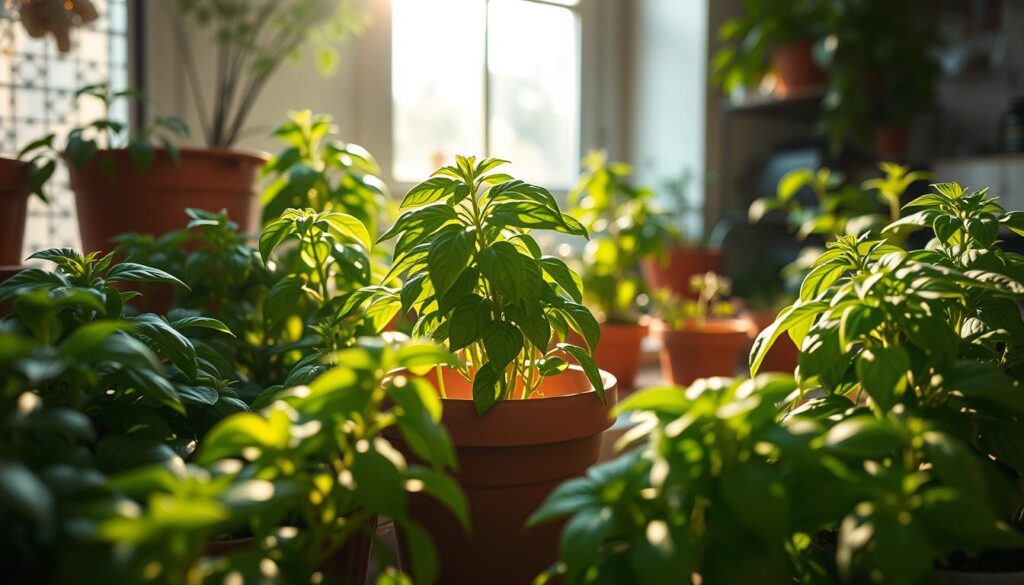
“The secret to growing basil indoors is to provide the right amount of light, water, and nutrients. With a little care and attention, you can have a thriving basil plant that delivers a steady supply of fresh leaves.”
Nutrient Requirements and Fertilization
Keeping your indoor basil plants healthy means giving them the right nutrients. Whether in soil or hydroponics, knowing how to fertilize is crucial. This ensures your basil grows well.
Soil-Based Nutrients
Basil loves nutrients and needs them often. The soil you start with will run out over time. To keep your basil happy, add fertilizer for indoor basil like blood meal or alfalfa meal to the soil before planting. These add nitrogen, which is key for healthy growth.
For basil that lives longer, use slow-release organic fertilizer or more alfalfa/blood meal every few months. This keeps the nitrogen levels up and meets the basil’s needs.
Hydroponic Nutrients
Hydroponic basil needs liquid nutrients added regularly. You should add these nutrients every 7-10 days or follow the manufacturer’s advice. This keeps your basil plants getting the minerals and trace elements they need.
“Proper fertilization is crucial for growing healthy, flavorful basil indoors year-round.”
By knowing what nutrients basil needs, you can grow a lot of tasty basil indoors, any time of year.
Pruning and Harvesting Indoor Basil
Keeping your indoor basil plants healthy is rewarding and can give you fresh leaves all year. Pruning is key to pruning indoor basil and making it bushy. It’s not just about cutting; it’s about making your plant thrive.
When your basil is about 6 inches tall, it’s time to prune. Cut the main stem just above a leaf set with clean, sharp scissors. This makes the plant grow more and look fuller. Do this every 2-3 weeks to maintain indoor basil and keep it looking great.
Letting your basil flower can make the leaves taste bad. To avoid this, remove the flowers and trim your plants often. This keeps your harvesting basil from indoor plants fresh and tasty.
“Pruning and harvesting your indoor basil is a delicate dance, but with a little practice, you’ll be rewarded with a thriving, bountiful herb garden right in your own home.”
With these easy tips, you can easily prune indoor basil and harvest basil from indoor plants. You’ll have this versatile and tasty herb all year.
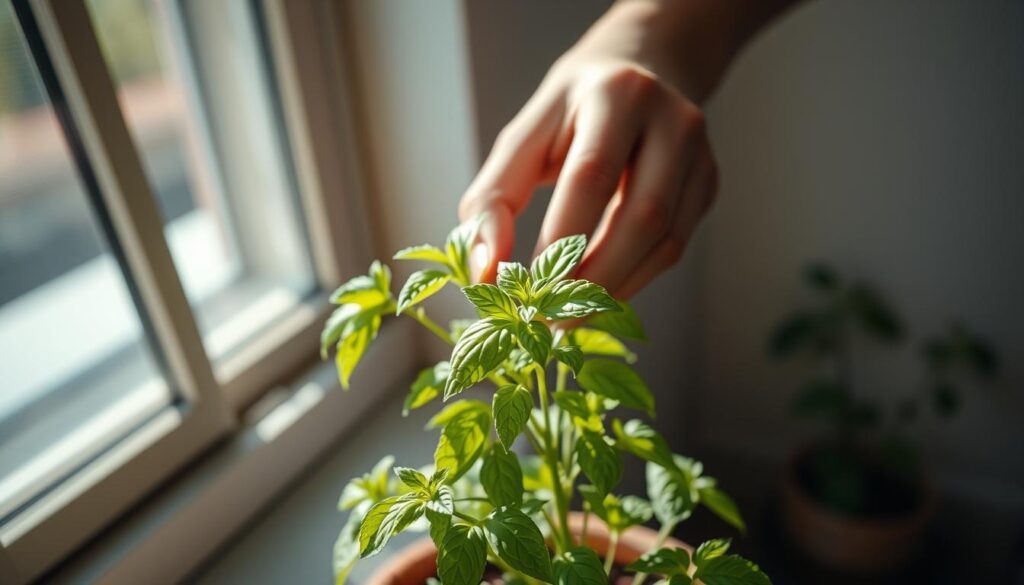
Starting Basil from Seeds or Cuttings
Want to start your own indoor basil garden? You can grow basil from seed or use cuttings. Both methods are easy and rewarding. Let’s look at the best ways to start basil plants indoors.
Germinating Basil Seeds
Growing basil from seed indoors is a great way to start early. First, soak a good seed starting mix and plant the basil seeds 1/4 inch deep. Keep the soil moist and warm, around 75-80°F. Seeds should sprout in 5-10 days under the right conditions.
Rooting Basil Cuttings
You can also propagate basil cuttings from a mature plant. Choose 4-inch stem cuttings and remove lower leaves. Put the cuttings in a glass of water. Roots should appear in 7-10 days.
Once roots are 1-2 inches long, move the cuttings to a pot with good drainage or a hydroponic setup.
Whether you start with seeds or cuttings, with proper care, you’ll have plenty of fresh, tasty basil at home.
Common Issues and Solutions
Growing basil indoors can sometimes come with challenges, but don’t worry. With the right strategies, you can easily solve these problems. This way, you can enjoy fresh, tasty basil all year.
Pests and Diseases
Indoor basil pests and diseases are common issues. Pests like fungus gnats, aphids, spider mites, whiteflies, and thrips can harm your basil. They can damage leaves and slow down growth.
- To keep indoor basil pests away, make sure your basil isn’t sitting in water. Let the soil dry out a bit between waterings.
- If you see disease signs like discoloration or spots, act fast. Cut off the affected leaves and use a mild, organic pest control solution.
Also, watch the temperature and humidity in your growing area. Changes in these can cause indoor basil problems and slow growth.
“Proper pest management and environmental control are key to preventing issues with indoor basil and ensuring a thriving, year-round harvest.”
Stay alert and tackle indoor basil pests and diseases early. This way, you can troubleshoot indoor basil problems and keep your plants healthy. With a bit of care, you’ll enjoy fresh, homegrown basil all year.
Conclusion
Growing basil indoors is a rewarding experience. It lets you have a steady supply of this tasty herb. This can make your cooking better.
Having fresh basil anytime is a joy. It also impresses your friends and family. This makes indoor basil gardening a great hobby.
You now know how to grow basil indoors. You can use a sunny windowsill, a high-tech setup, or something in between. Just make sure to watch the lighting, temperature, humidity, and nutrients for your basil.
Starting your indoor basil journey brings a sense of pride. You’ll be able to give your family this aromatic and flavorful herb. With a bit of care, you’ll enjoy the fruits of your labor. You’ll be proud of growing fresh basil all year.
FAQ
What are the benefits of growing basil indoors year-round?
Why is basil a great plant for indoor gardening?
What are the different methods for growing basil indoors?
How much sunlight does basil need when grown indoors?
What are the ideal temperature and humidity levels for growing basil indoors?
What type of growing medium and containers are best for indoor basil?
How can I grow basil indoors year-round?
How do I fertilize and prune indoor basil plants?
What common issues may arise when growing basil indoors, and how can I address them?
Source Links
- Growing Basil Indoors All Year Long – https://www.epicgardening.com/growing-basil-indoors/
- How To Grow Basil Indoors 🌿 and Elevate Your Home Cooking – https://www.gardeners.com/how-to/basil-indoors/8930.html?srsltid=AfmBOorT0KlImXCaqVuIq7qTmOXP_WRxaLz_aka3MXlnQzNyqoD-xFWn
- How to Grow Basil Indoors to Enjoy All Year Long – https://www.bhg.com/gardening/vegetable/herbs/how-to-grow-basil-indoors/


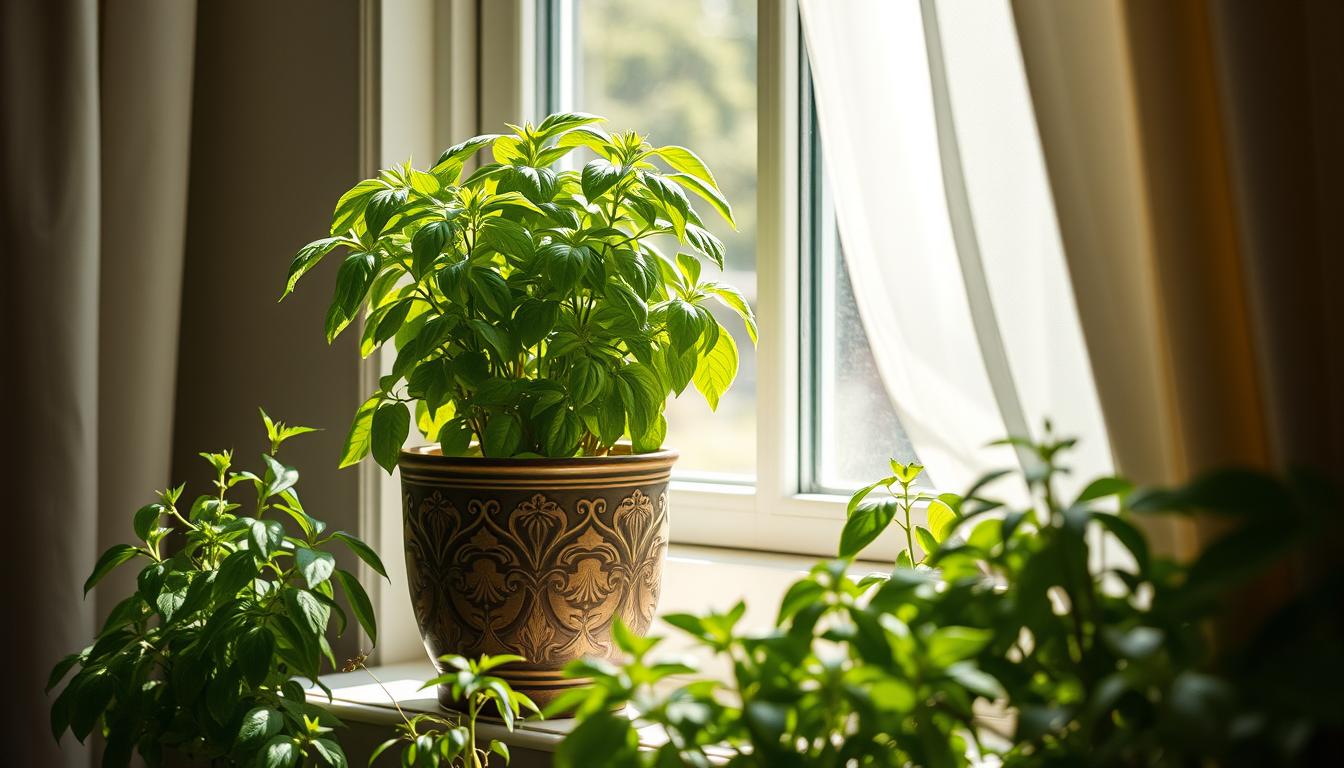
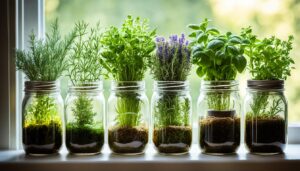
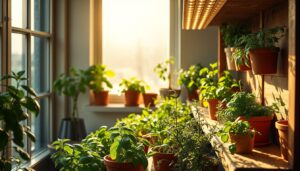
Pingback: Mastering Basil: Growing, Harvesting, and Propagating for Endless Fresh Herbs